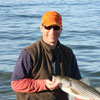3 Types of Fish Habitat Restoration Efforts Improving Water
By Tom Keer
Sep 07, 2017
One reason we have so many fish to catch is because of strong conservation practices. These three groups are some of the many great organizations that enhance rivers, lakes and habitat. Get involved and help improve our fisheries!
When it comes to fishing conservation, catch-and-release isn't enough. Responsible fishing includes catch and release, but it's best combined with stream and environmental restoration. Sometimes fish habitat restoration isn't enough and fish rearing is required. Here are 3 groups that work on fish habit restoration to provide anglers with better angling opportunities.
1. Lake Restoration
Restoring habitat in lakes is a key element of B.A.S.S. Nation clubs (www.bassmaster.com). This year, the Bass Angling Southern Style Fishing Club worked with the NC Wildlife Resources Commission to place fish attractors in Sutton Lake near Jacksonville, NC. After conducting a sonar survey of the attractor sites, biologists determined improvements were important to provide bass with proper cover. In a lake restoration effort, a dozen Mossback Trophy Tree attractors were added to targeted areas in the lake. Largemouth bass use these areas for protection from predators and are part of the process used to cultivate larger fish populations.
2. Stream Restoration
Stream habitat restoration has been a cornerstone of Trout Unlimited's efforts since the organization was founded (www.tu.org). TU's overarching goal is to create healthy streams and rivers that support strong fish populations. Restoring brook trout to West Virginia's Potomac Headwaters required reconnecting 7 miles of headwater springs, restoring 3 miles of habitat using rocks and logs to create pools, runs and to stabilize banks, and to protect 100 acres of habitat through fencing, planting and securing conservation easements. Over 350 volunteers were involved in this fish habitat restoration effort.
3. Species Restoration
Stocking fish following environmental restoration is ideal. In the case of the Atlantic salmon which is on the Endangered Species List, a different approach is needed. The Peter Gray Parr Project (www.wildatlanticsalmon.org) uses scientifically-proven methods developed by the late Peter Gray. The parr are raised in a stream-side hatchery that flows water from the river in which they were born. Water velocities are increased to condition the fish for survival, and they are stocked in the fall when their metabolism slows and they don't need to look for food. More parr survive and migrate to sea where they have a chance to return to spawn. And there is much more work to be done to get the Atlantic salmon off of the endangered species list.
Fish habitat restoration represents conservation at its most important level. Get involved where you can and help make a difference.









